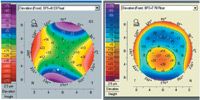Article
Elevation topography can be a helpful screening tool before refractive surgery
Elevation topography can be a useful tool in screening patients for LASIK to lessen the chance of the development of ectasia. An ophthalmologist offers tips for using this technology effectively.

Key Points

"A lot of these cases of ectasia in 'normal' eyes are in eyes that were not properly evaluated," said Dr. Belin, professor of ophthalmology and director of refractive surgery, Albany Medical College, Albany, NY.

"That is a great instrument and will not do you any harm," he said, "but realize that there are a couple of assumptions when we use curvature-it's not really Placido, it's curvature-and those are that we make an assumption that our reference axis or our measurement axis is geometrically the center of where the patient is looking but, more so, we're limited to looking at the anterior surface of the cornea."

"We have to understand that at times, normal maps may look abnormal," Dr. Belin said.
Elevation topography helps eliminate the chance of mistakes, said Dr. Belin, also in private practice with Cornea Consultants of Albany, Slingerlands, NY.
Newsletter
Don’t miss out—get Ophthalmology Times updates on the latest clinical advancements and expert interviews, straight to your inbox.




